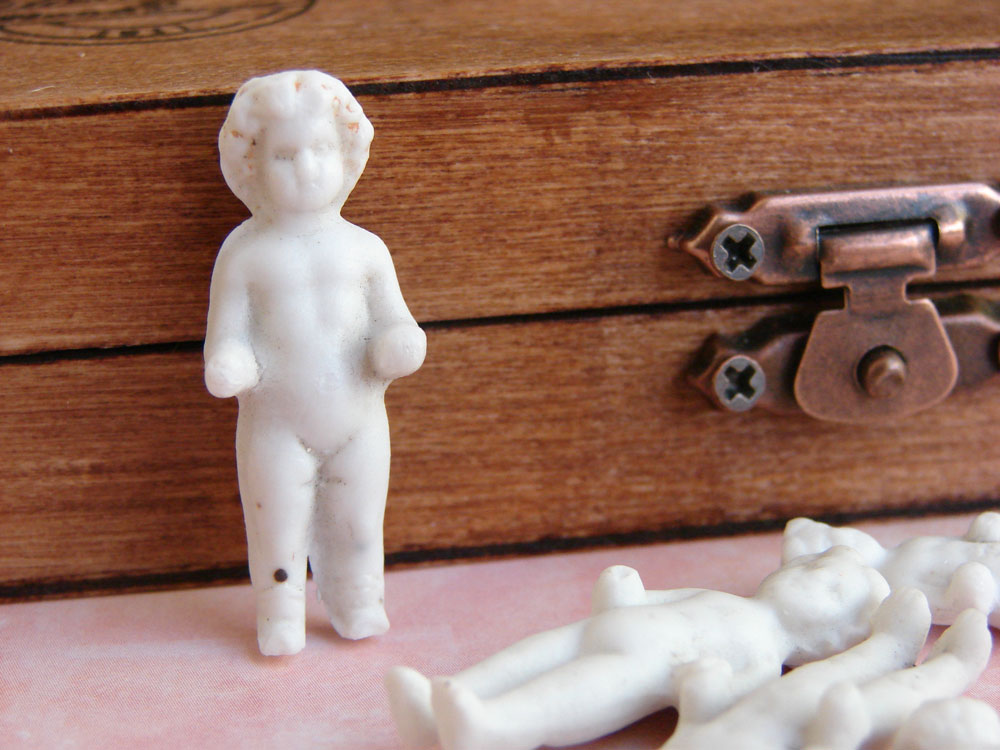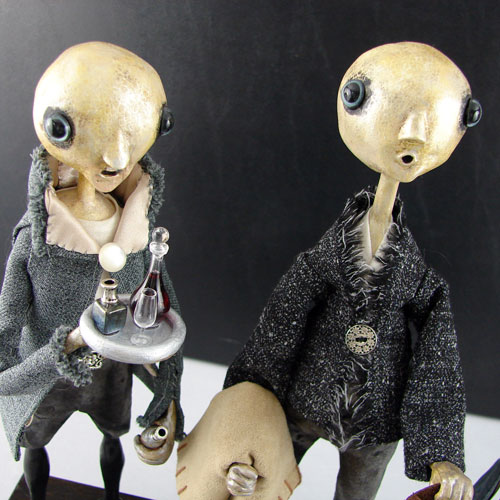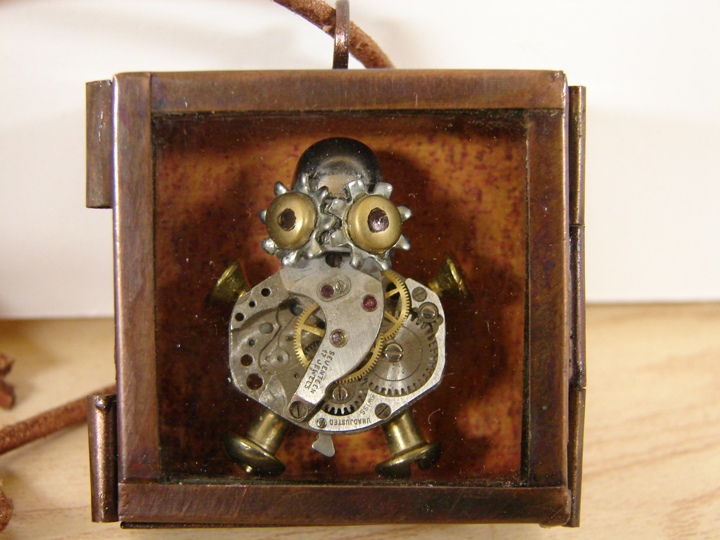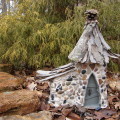What is it about these strange tiny dolls that makes assemblage artists go gaga? Frozen Charlottes are ubiquitous in mixed media and altered art creations, whether shabby chic, grungy and distressed, or Victorian sweet. Flawed and discolored, they can lend a creepy or tragic feeling to artwork. Some folks love ’em, some folks hate ’em.
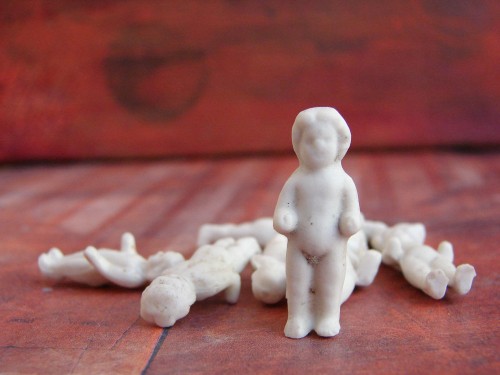
What Is A Frozen Charlotte?
A Frozen Charlotte is a miniature china doll made in Germany from the 1850’s to around 1920. They are made in the form of a standing, naked figurine molded in one piece with unjointed (frozen) arms and legs. Ranging in height from around 1″ (25mm) to 4″ (100mm), they were typically made from porcelain, usually white in color, and either glazed or unglazed.
Frozen Charlottes were mainly manufactured in Germany by doll companies and sold by the gross. The 1″ (25mm) dolls were commonly known as ‘penny dolls’ as they sold for one cent in America. (There is also a male doll called Frozen Charlie.) The dolls were popular with children in the late 19th and early 20th centuries. Some floated on their backs; they had porcelain fronts and unglazed backs and were played with in the bathtub. Smaller ones were frozen and placed in cups to cool afternoon tea. Tiny versions could be used as charms or party favors and baked into birthday cakes or added to Christmas puddings (much like is done with Mardi Gras king cakes). Children also played with them in doll houses or simply collected them.
Dolls that came through the firing process intact were hand-painted. Those that broke during firing or were otherwise flawed were dumped in trash piles behind the factories and eventually covered over. Today, many Frozen Charlottes are being excavated from the grounds of old doll factories in Germany, mainly Thuringia. They are highly collectible, not only among doll enthusiasts, but also artists, who perhaps appreciate the imperfections, believing that the broken limbs and dirt encrusted surfaces add to their charm.
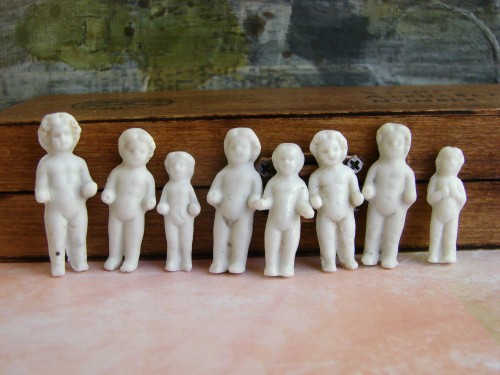
Why Are They Called “Frozen Charlottes”?
These diminutive dolls take their name from a poem written by Maine humorist and editor Seba Smith (1792-1868) who was reportedly inspired by a February 8, 1840, article in the New York Observer about a young woman who was frozen to death while riding to a New Year’s Eve ball in an open sleigh. The poem was set to music by William Lorenzo Carter and is still sung today by American folk singers.
In the poem, our heroine, Charlotte, refused to heed her mother’s urging to wrap up warmly for fear of hiding her pretty gown. Her sweetheart drove quickly to the ball in town, but was horrified to find that Charlotte froze to death during the trip. Here is the poem in full:
Young Charlotte
by Seba SmithNow, Charlotte lived on the mountainside,
In a bleak and dreary spot;
There was no house for miles around,
Except her father’s cot.
And yet on many a wintry night,
Young swains were gathered there;
For her father kept a social board,
And she was very fair.One New Year’s Eve as the sun went down,
Far looked her wishful eye
Out from the frosty window pane
As merry sleighs went by.In a village fifteen miles away,
Was to be a ball that night;
And though the air was heavy and cold,
Her heart was warm and light.How brightly beamed her laughing eye,
As a well-known voice was heard;
And driving up to the cottage door,
Her lover’s sleigh appeared.“O, daughter dear,” her mother cried,
“This blanket ’round you fold;
It is a dreadful night tonight,
You’ll catch your death of cold.”“O, nay! O, nay!” young Charlotte cried,
And she laughed like a gypsy queen;
“To ride in blankets muffled up,
I never would be seen.“My silken cloak is quite enough,
You know ’tis lined throughout;
Besides I have my silken scarf,
To twine my neck about.”Her bonnet and her gloves were on,
She stepped into the sleigh;
Rode swiftly down the mountain side,
And o’er the hills away.With muffled face and silent lips,
Five miles at length were passed;
When Charles with few and shivering words,
The silence broke at last.“Such a dreadful night I never saw,
The reins I scarce can hold.”
Fair Charlotte shivering faintly said,
“I am exceeding cold.”He cracked his whip, he urged his steed
Much faster than before;
And thus five other dreary miles
In silence were passed o’er.Said Charles, “How fast the shivering ice
Is gathering on my brow.”
And Charlotte still more faintly said,
“I’m growing warmer now.”So on they rode through frosty air
And glittering cold starlight,
Until at last the village lamps
And the ballroom came in sight.They reached the door and Charles sprang out,
He reached his hand for her;
She sat there like a monument,
That has no power to stir.He called her once, he called her twice,
She answered not a word;
He asked her for her hand again,
And still she never stirred.He took her hand in his – O, God!
‘Twas cold and hard as stone;
He tore the mantle from her face,
Cold stars upon it shone.Then quickly to the glowing hall,
Her lifeless form he bore;
Fair Charlotte’s eyes were closed in death,
Her voice was heard no more.And there he sat down by her side,
While bitter tears did flow;
And cried, “My own, my charming bride,
You never more will know.”He twined his arms around her neck,
He kissed her marble brow;
His thoughts flew back to where she said,
“I’m growing warmer now.”He carried her back to the sleigh,
And with her he rode home;
And when he reached the cottage door,
O, how her parents mourned.Her parents mourned for many a year,
And Charles wept in the gloom;
Till at last her lover died of grief,
And they both lie in one tomb.
What Are They Worth?
Frozen Charlottes range in value from a few dollars into the hundreds for a rare and pristine piece. Here are some qualities that may cause a doll to be valued more highly:
- unusual poses
- black skin paint
- unusual hair styles or color
- shiny glazed white porcelain
- meticulously painted facial features
- molded chemises or other clothing
- hand-painted bows, stockings or other details
Many types of dolls may be called Frozen Charlottes but true Charlottes have no jointed appendages.
How To Use Frozen Charlottes In Your Art
Frozen Charlotte dolls are ideal for any mixed media, jewelry, or assemblage projects. Use them as is for Victorian shabby chic style jewelry or grunge them up even more for steampunk or Halloween art.
Here are some ideas and tutorials to get you started:
Halloween Frozen Charlotte Tart Tin Art Tutorial
Frozen Charlotte Fairies
Make A Mold of A Frozen Charlotte
Please also see my Pinterest page for many beautiful art projects incorporating Frozen Charlottes.
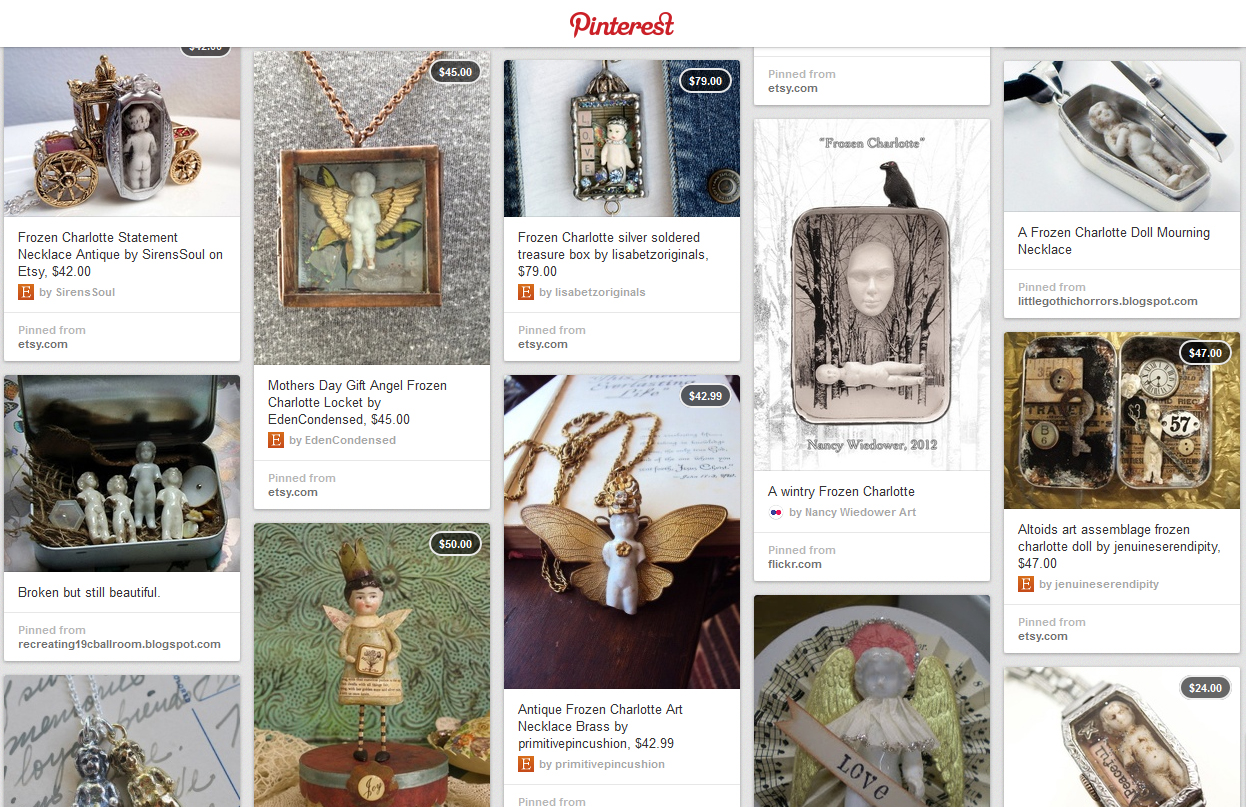
Where To Buy Frozen Charlottes
Here, of course! I sell them here on Trilby Works and through my Etsy store. If you can’t afford to buy authentic Charlottes, Tim Holtz, the guru of mixed media, offers replications made of glazed resin that he calls Fractured Dolls. You can buy them online at Amazon.com and other art and craft sites.
Sources
Frozen Charlotte Doll a Cool Find by Nancy Russell
Frozen Charlotte And Charlie Antique Doll Buyers Guide on eBay
Young Charlotte poem

